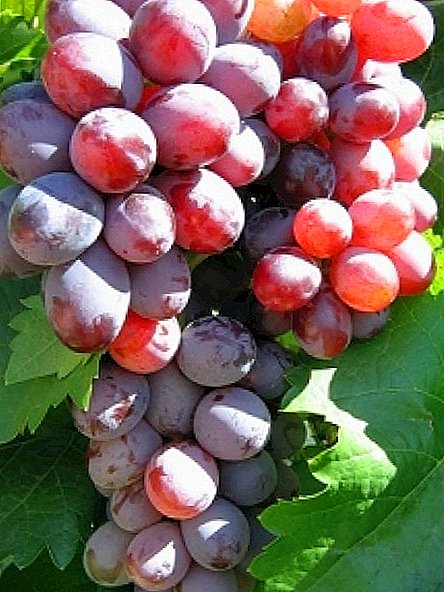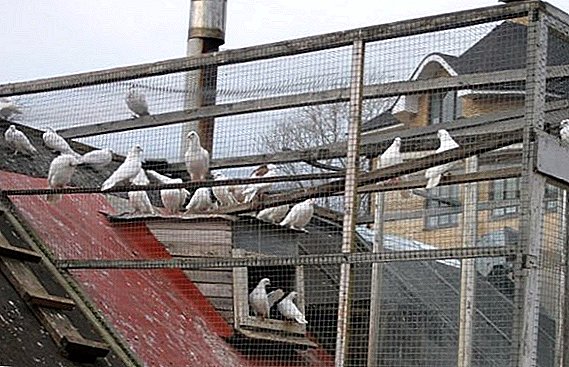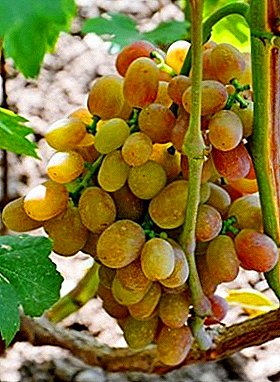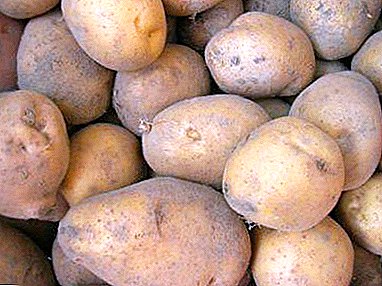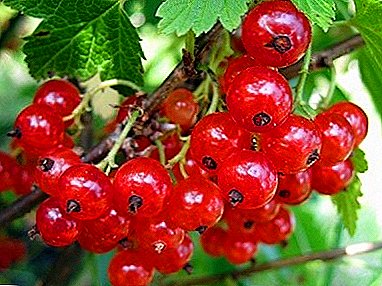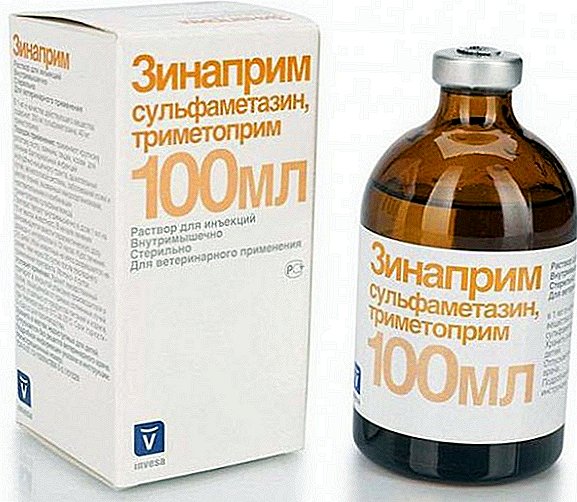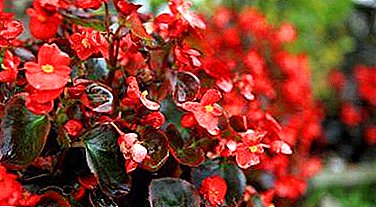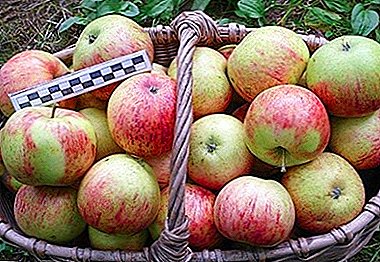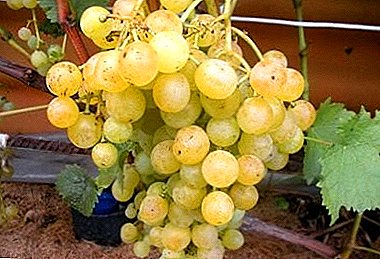
Grapes "Tukay" is grown in many regions of Russia. It has established itself as a winter-hardy, hardy and ripening in early terms.
And the keeping quality of its fruits is simply amazing - the harvest is able to be stored almost all winter.
Considering all the characteristics of this variety, it is possible to grow an excellent harvest of Tukay's sweet and aromatic berries every year.
What kind is it?
White grape "Tukay" refers to table varieties with very early ripening. It is quite popular among amateur gardeners. The variety consistently gives high yields, and its berries have excellent taste.
"Tukay" is grown for fresh consumption of berries and cooking compotes.
Among the white table varieties are also known Delight White, Amethyst Novocherkassky and Amirkhan.
Tukai grapes: variety description
 The Tukai grape variety is a strong-growing and widening bush with a strong and well-ripening vine.
The Tukai grape variety is a strong-growing and widening bush with a strong and well-ripening vine.
The leaves on its shoots are small. In shape, they are egg-shaped with a slightly split middle center and integral along the edges. The grapes are large, weighing from 800 g to 1.5 kg. The shape of the clusters is cylindroconic and branched, characterized by medium friability without pea.
The weight of berries "Tukay" hesitates from 2 to 6 g. The shape of the fruit is oval, and the color is yellowish-green. Ripening in the bright sun, they acquire a well-marked brownish "tan".
The berries have a juicy and crispy flesh with a pleasant sweet-sour taste and light muscatel notes. Their skin is strong and very thick, but when chewed, it is almost not felt.
Muscat Summer, Gift Nesvetaya and Platovsky have a pronounced muscat flavor.
The amount of sugar in the berries - from 17 to 19%and acidity is from 5 to 6 g / l. Professional tasters rated the taste of grapes "Tukay" at 9 points.
Reference: Flowers "Tukai" bisexual, so he does not need varieties of pollinators.
Bisexual flowers also have Vodogray, Liana and Libya.
A photo
Photo grapes "Tukay":


Breeding history and breeding region
"Tukay" withdrawn famous breeders VNIIViV named Ya. I. Potapenkolocated in the city of Novocherkassk and gave the world a lot of popular grape varieties.
Parents "Tukaya" - Central Asian variety "Yakdona" and hungarian vintage variety Pearls Saba, from which the new variety adopted cold resistance and early maturation.
Such excellent varieties as Super Extra, Beauty of the North, Isabella can boast excellent frost resistance.
These qualities allow you to successfully grow "Tukay" not only in southern Russia, but also in the North-Western and Central parts of the country, as well as in the Urals and Siberia.
Specifications
The variety produces high and stable yields.
In the middle lane, you can feast on grapes "Tukay" in July.
The variety has a high yield safety. Ripe berries can remain on the bush for a long time without losing their taste.
The original, Attica and the Knight also show the ability to be well stored after collection.
And after harvesting the grapes "Tukay" can be kept fresh until April next year. This quality puts "Tukay" in the first place in the keeping quality of the crop among European varieties.
He showed himself well and in transportation - the berries do not crack and do not crumple in transit.
Reference: For long-term storage, grapes are placed in a dark ventilated room with a stable temperature from 1 to 8 ° C. This may be a deep basement, pantry or refrigerator.
 The variety is prone to overloading fruit inflorescences, because of which the size of the fruit and the mass of the clusters decreases.
The variety is prone to overloading fruit inflorescences, because of which the size of the fruit and the mass of the clusters decreases.
For this reason, "Tukay", as well as Dubovsky Pink and Vodogray need to rationing the crop.
For this, a short and medium pruning of shoots is carried out in the fall, and in the spring weak shoots and excess buds are removed. Wherein load on the bush "Tukaya" must be from 35 to 45 eyes. When pruning fruit-bearing vines should be left on them from 6 to 8 eyes.
"Tukay" frost hardy enough. He is able to withstand the winter cold with air temperature to -23 ° C. The same characteristics of frost resistance possess Richelieu, Rusven, and Nizin.
However, in regions with stronger frosts, it is necessary to cover grapes for winter. For this, the vines removed from the trellis are pressed to the ground and covered with a warming material. Next on top of the shelter is placed an additional protective layer in the form of a coniferous twig. All work should be carried out in dry weather to prevent moisture from getting inside the winter shelter.
Place for landing "Tukay" should choose sunny and protected from cold winds.
Ideally, this should be the south side of any building. After all, the more sun the grape bushes get, the tastier the berries will be and the harvest will be more abundant.
To the composition of the soil variety is not demanding, but will refuse to grow on highly wetted, marshy and saline lands. When planting grapes in a sandy soil, compost or manure is applied, and drainage is necessarily added to clayey or loamy soil.
"Tukay" successfully propagated by cuttingswhich rooted easily and quickly. The recommended phylloxero-resistant stock for this variety is a hybrid. Riparia x "Rupestris 101-14".
Diseases and pests
 Grade "Tukay" defies gray mold, but subject to such diseases like oidium and mildew. With the defeat of oidium on the green parts of the plant appears ash-gray color with the smell of mold and rotten fish.
Grade "Tukay" defies gray mold, but subject to such diseases like oidium and mildew. With the defeat of oidium on the green parts of the plant appears ash-gray color with the smell of mold and rotten fish.
At the same time, the diseased inflorescences dry up, the berries harden and crack. Oidium is hampered by rainy weather and abundant dew.
For protection vineyard from the disease double preventive treatment of plants with 3% solution of iron or copper sulphate - in early spring after the opening of the bushes and at the beginning of the growing season.
For the cultivation of environmentally friendly grapes, experienced gardeners advise treating bushes with a biological product based on hay rot, which inhibits the causative agents of oidium.
To make it, you need one part of hay dust (you can replace it with a dry mullein) and pour three parts of clean rainwater. It is necessary to put the solution for three days in a dark and warm place.
The resulting composition must be filtered and diluted in three parts of water. Spraying of plants should be carried out in cloudy weather, because the sun's rays kill the beneficial microflora.
Number of treatments not limited.
Mildew is considered the most dangerous disease for grapes. All aboveground parts of the plant suffer from it. The first sign of infection is the appearance of a white powdery deposit on the underside of the leaves, after which they turn brown, dry, and then fall off.
Without measures taken in time, the entire crop may perish. In the protection of grapes from mildew, preventive measures play a very important role:
- thinning bushes for better ventilation;
- soil mulching under the vineyard;
- regular scattering of ash around the bushes and under them;
- top dressing with nitrogen fertilizers in a minimum amount (overdose of nitrogen leads to 100% mildew).
 In addition, to protect the grapes from mildew preventive spraying of plants. Late autumn cut bushes and soil in the vineyard process iron sulphate (400 g per 10 liters of water).
In addition, to protect the grapes from mildew preventive spraying of plants. Late autumn cut bushes and soil in the vineyard process iron sulphate (400 g per 10 liters of water).
In the spring of May and in the summer of June, the grapes are sprayed with Bordeaux mixture or its analogues. The deadline for the last treatment should be no later than a month before harvest.
These and other preventive measures can protect your grapes from all sorts of diseases, including anthracnose, chlorosis, bacteriosis, rubella and bacterial cancer. More about these misfortunes we tell in separate materials of the site.
The Tukai variety may be attacked by a felt tick (aka grape pruritus). The signs of a pest attack are the appearance of green and then reddish bulging spots on the leaves. On the reverse side of the stain, on the contrary, are depressed and as if covered with gray felt.
It is difficult to fight grape pruritus, as it settles on the underside of the leaf, hiding behind "felt" protection. With a small lesion pruning and destruction of infected leaves.
With a significant number of pests bushes processed by colloidal sulfur. This is done at a temperature not lower than 20 ° C, so that the sulfur fumes penetrate the itch protection and kill it.
In addition, they are effective against felt mites. "Tiovit Jet", "Karbofos", "Fufanon" and "Fitoverm".
To protect the grapes from birds, various scarers, sound rattles and loudspeakers, shiny ribbons and balls, metal nets over the vineyard are used.
 And such lovers of grapes, like wasps, are eliminated with the help of sweet traps. It is also important initially to prevent the settlement of wasps on the site.
And such lovers of grapes, like wasps, are eliminated with the help of sweet traps. It is also important initially to prevent the settlement of wasps on the site.
To do this, you should regularly bypass it in search of wasp nests and destroy them. Excellent cope with protection of the crop against wasps and birds, special nets, dressed in bunches.
Of course, the grape "Tukay" deserves the attention of a gardener engaged in viticulture. This is a reliable variety that can give a rich harvest of long-term storage. It is only necessary to provide him with the necessary conditions and protect him from diseases and pests.


